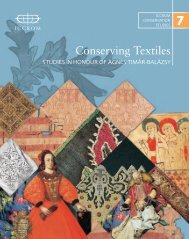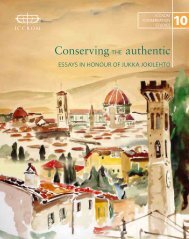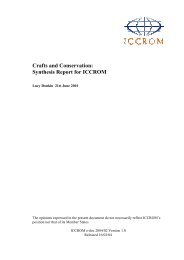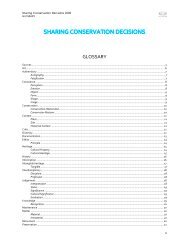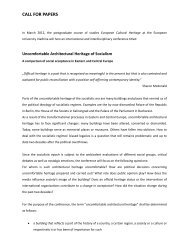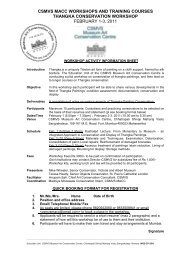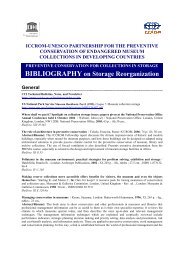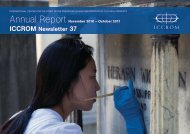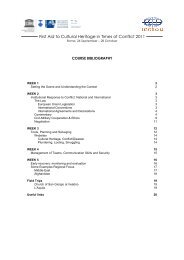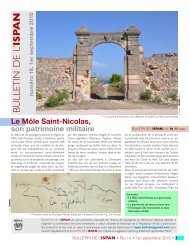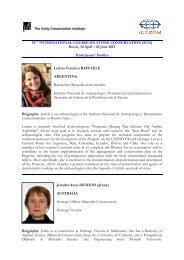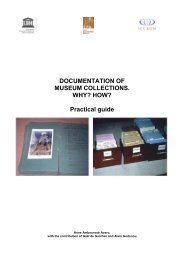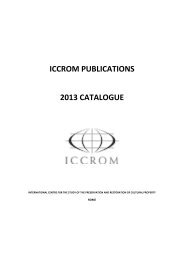part 1 - Iccrom
part 1 - Iccrom
part 1 - Iccrom
Create successful ePaper yourself
Turn your PDF publications into a flip-book with our unique Google optimized e-Paper software.
MEASURING HERITAGE CONSERVATION PERFORMANCE<br />
6th International Seminar on Urban Conservation<br />
Figure 5. Temperature and Relative Humidity graphics of Entomological Collection – room and drawer (Source:<br />
De<strong>part</strong>amento de Patrimônio Histórico/COC/Fiocruz).<br />
Regarding the Entomological Collection, monitoring<br />
data collected in the room indicates high levels<br />
of relative humidity and temperature (sometimes<br />
exceeding 75% RH and 30°C), though the environment<br />
does not possess any type of mechanical climate<br />
control system. The analysis of data collected<br />
in the drawers of the collection, however, indicate<br />
that the entomological drawers and the sliding file<br />
sealing system had been functioning as barriers to<br />
the conditions identified in the room, ensuring a<br />
more stable micro-environment with reduced values<br />
in relation to RH and temperature (Figure 5).<br />
To complement the survey data related to temperature<br />
and relative humidity, data for rainfall and<br />
wind movement in Rio de Janeiro were collected<br />
through the site INMET (National Institute of Meteorology).<br />
The institution has a database of measurements<br />
that have been conducted since the 1930s, and<br />
provides consultation on the Climatological Standards;<br />
a selection of data from each of the indices<br />
mentioned above were converted into monthly<br />
averages. For the study, the most recent standards<br />
(1961-1990) were raised. Data analysis will allow a<br />
deeper understanding of the macro-environment of<br />
the building and its impact on the conservation of<br />
the building and the collections housed there.<br />
2.2. Diagnostics of the building<br />
and the collections<br />
The diagnostic stage was divided into three phases:<br />
preliminary survey data, observations and interviews<br />
on the site, and analysing data and defining strategies.<br />
The diagnostic process should always be started<br />
with a review of all available information about the<br />
building and collections, given that the literature<br />
on a heritage may reveal information that cannot<br />
be obtained through direct observation. During the<br />
first phase of the diagnostic process, the existence<br />
of abundant technical documentation was identified<br />
relating to works undertaken in the Moorish<br />
Teixeira Coelho, A. M. & .C. S. Rodrigues de Carvalho. 2012. The conservation assessment as a tool for cultural heritage identification,<br />
monitoring, and evaluation. In Zancheti, S. M. & K. Similä, eds. Measuring heritage conservation performance, pp. 82-89. Rome, ICCROM.<br />
87



